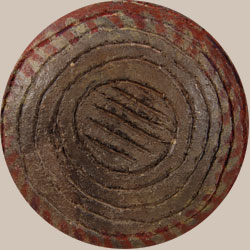Casas Grandes Polychrome Figural Jar [SOLD]
+ Add to my watchlist Forward to Friend
- Category: Pre-Columbian or Prehistoric
- Origin: Mexico
- Medium: clay, pigment
- Size: 3-1/4” deep x 4-1/2” diameter
- Item # C3309C SOLD

Casas Grandes pottery was first produced about 1000 years ago in an area of Northern Mexico called Paquimé. At first the pots were strictly utilitarian vessels. Eventually, their style, shape and quality transformed through trade with the Hohokam and Anasazi. Casas Grandes potters were exceptional artists, leading to the conclusion that other developed peoples moved there and immediately created fine wares.
There were migrations from what is now the American Southwest that perhaps ended in Mexico and the establishment of Paquimé, a multistory pueblo that appeared around 1250. Excavations have revealed that it was the largest of all the ancient pueblos. J. Walter Fewkes, head of the Bureau of American Ethnology of the Smithsonian Institution published a report in 1914 with numerous comparisons between Mimbres and Casas Grandes pottery. Pottery found in excavations of Paquimé has been referred to as Casas Grandes pottery, and is dated between 1250 and 1400. Casas Grandes pictorial pottery is quite similar to Mimbres pictorial pottery.
The incisions encircling this jar are reminiscent of American prehistoric wares that clearly illustrate the construction of the jar through coils of clay. Red paint has been carefully applied to the surface of the jar in a manner that leaves images which appear to be frogs. Perhaps the potters there put water creatures on pottery much like today's New Mexico potters do.
Condition: very good condition
Recommended Reading: Casas Grandes and the Ceramic Art of the Ancient Southwest, edited by Richard F. Townsend
Provenance: from the collection of Katherine H. Rust
- Category: Pre-Columbian or Prehistoric
- Origin: Mexico
- Medium: clay, pigment
- Size: 3-1/4” deep x 4-1/2” diameter
- Item # C3309C SOLD



